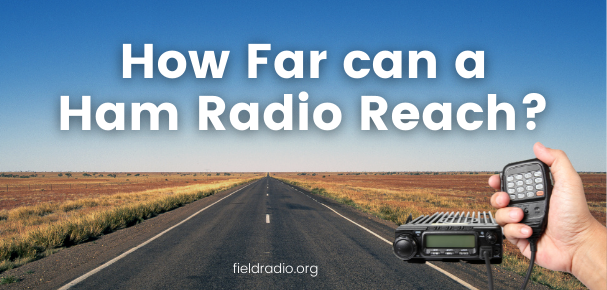The need for a ham radio oscilloscope is not often discussed in the amateur radio community. The low cost of many modern digital signal processing (DSP) based equipment has made it possible to analyze signals without an oscilloscope.
However, there are still occasions when an oscilloscope provides value that other instruments cannot provide. This article will discuss some of these instances and explain why you might want one even if you don’t “need” one right now.
What is an Oscilloscope
An oscilloscope is essentially an instrument that you can use to measure frequencies either In GHz or MHz, depending on your requirements. It is a device that ham radio users use to measure electric signals from their ham radio.
An oscilloscope is a graphing device, and it has a great relationship with different electronics, one of which is the ham radio.
Many ham radio owners use an oscilloscope with their ham radios to visualise voltage change over time. Since not all electronic circuits, including ham radio, can boast a stable voltage supply, having an oscilloscope becomes necessary.
This is because an oscilloscope lets you find and fix where voltage is not acting as it should.
The oscilloscope has a small screen where ham radio users can see how signals interact on the graph, with time on the horizontal axis and voltage on the vertical axis.
It is how you can analyse how a circuit behaves. If your ham radio were a dish, an oscilloscope would be the eyes you use to guide the preparation of your dish and the tongue you use to taste it.
Through the interaction of the voltage and time on the graph, you can use your oscilloscope to determine clock frequencies, signal rise and fall times, propagation delay, etc.
Summarily, your oscilloscope helps you determine if a signal has the required frequency, waveform, etc.
History of Oscilloscope
French physicist André Blondel built the first oscilloscope in 1893. This oscilloscope was an electromechanical design, and it registered the values of electrical quantities.
One of these values the device could register was alternating current intensity. The device registered the values on a mobile paper tape with an ink pendulum which was connected to a coil.
Needless the say, the results of this oscilloscope were inaccurate, but technology has evolved to make oscilloscopes more precise.
In fact, through technological advancement, we now have two types of an oscilloscope. They are analogue and digital oscilloscopes.
We will discuss more these two types of oscilloscope at another heading in this article.
Types of Oscilloscopes: Analogue And Digital
Oscilloscopes for ham radio come in two types. These types are the analogue and digital types. There are some stark differences between the two.
One of these differences appears in how they work. Specifically, an analogue oscilloscope works by applying the voltage being measured to a beam dashing across the screen.
The voltage interacts with the beam, deflecting it to move in an up and down sequence. This way, you see in real-time, the waveform and it’s time stamps.
On the other hand, a digital oscilloscope tests the waveform and convert the voltage it measures into digital information with its analogue to digital converter.
Afterwards, the digital data is used to reconstruct the waveform.
While this is not a recommendation, you don’t need to be stuck with your analogue oscilloscope as the digital oscilloscope and its parts are beginning to saturate the market.
What is an Oscilloscope Used For In Ham Radio
An oscilloscope measures electric signals from your ham radio. Ham radio users visualise the change of voltage over time.
Voltage can be a problem for electronic circuits devices, and this includes the ham radio. So, in a situation where the ham radio, like other electronics, can’t boast of a stable supply of voltage, having an oscilloscope becomes necessary.
This is because an oscilloscope lets you find and fix issues regarding voltage not acting as it should.
So, an oscilloscope helps you be able to measure electric signals from your ham radio. This measurement is done through the controls on your ham radio which measure specific things. A regular Oscilloscope for your ham radio has four controls.
They are the vertical, horizontal, trigger and acquisition system controls, and you use these controls on your ham radio to measure certain things.
How Does an Oscilloscope Work?
Just above, we mentioned that an oscilloscope measures the electric signals from your ham radio. The measurement is done through the controls or system on your ham radio.
These controls or systems are four: horizontal, vertical, trigger and acquisition system controls. Essentially, the oscilloscope works and comes alive with these system controls.
Central to the above system controls is the probe. The probe interacts with these controls by providing the data they would need to work.
The vertical system interacts first with the probe in that it is the point of entry for the signals coming from the probe. This system regulates the power of a signal to the voltage requirement of other circuits.
The horizontal system helps in the measurement of voltage over time. This is because it contains the sample watch or clock that tag each voltage sample with a specific time coordinate.
The acquisition system provides the horizontal system with voltage samples as it samples the voltage signal and gets the required data to show it.
The trigger control system helps your ham radio discover specific conditions in the signal and attaches a time stamp on the signal in a waveform.
The discovered signal that met the specific criteria will be displayed along with the waveform before it or after it.
Final Thoughts
If you’re looking to measure a voltage, frequency or waveform in your electronics project and don’t have the right equipment on hand, an oscilloscope is just what you need. Oscilloscopes can be used as analog or digital devices depending on your needs.
For those of us who work with ham radio projects, this type of device may come in handy for troubleshooting transmissions problems. Being able to visually see what’s going on may be exactly what you need to get the communication back up and running.

I have been passionate about the world of communications in its various forms for most of my life. Ever since I first found an old ham radio stashed away in my uncle’s attic, I have had a fascination with this classic technology.
Having the ability to communicate with people without the need to rely on telephone lines or networks is an empowering feeling which I believe everyone should have at least a basic knowledge of. Becuase who knows when you might need it?
I setup fieldradio.org with this passion in mind, to help inform people about the amazing possibilities of amateur radio and I’m on a quest to help educate as many budding operators as possible.
I hope you enjoy our content. Come and say hi, via our contact form


